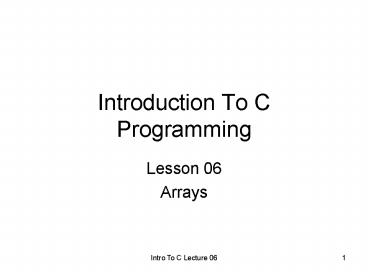Introduction To C Programming - PowerPoint PPT Presentation
1 / 21
Title:
Introduction To C Programming
Description:
3. Arrays. Array members are stored in sequential order in contiguous memory ... Notice the array is defined as size 6 to accommodate the null terminator. ... – PowerPoint PPT presentation
Number of Views:52
Avg rating:3.0/5.0
Title: Introduction To C Programming
1
Introduction To C Programming
- Lesson 06
- Arrays
2
Arrays
- An array is a collection of variables referenced
by the same name. - All of the variables are the same type
- Each variable, or array member, is accessed by an
index - The first array members index is 0
- The last array members index is at dimension-1
- e.g. int size10 / first element 0, last
element at 9 /
3
Arrays
- Array members are stored in sequential order in
contiguous memory - Can be one dimensional or multi-dimensional
4
Arrays
- Single dimension arrays are declared with this
format - type namesize
- The size must be a constant expression
- The size is used to determine how much space to
allocate - To define an array of 10 ints
- int score10
5
Arrays
- The first element is accessed as
- score0
- The last element is accessed as
- score9
- The number of bytes used by the array
- num_bytes size sizeof(type)
- num_bytes 10 sizeof(int)
- or, num_bytes sizeof(score)
- num_bytes 40 / if 4 byte ints /
6
- / global, static, auto array init /
- include ltstdio.hgt
- int val2 // global array
- int main(void)
- int i, zip2
- static int amt2
- for (i 0 i lt 2 i)
- printf(vald d\n, i, vali)
- for (i 0 i lt 2 i)
- printf(amtd d\n, i, amti)
- for (i 0 i lt 2 i)
- printf(zipd d\n, i, zipi)
7
Output
- val0 0
- val1 0
- amt0 0
- amt1 0
- zip0 4206168
- zip1 6618628
8
Arrays
- You may initialize an array at declaration time
- type namesize comma separated list of
values - int score3 2, 4, 6
9
for loops and arrays
- for loops are commonly used to process the
elements of an array - Typical use is
- define SIZE 10
- int arraySIZE
- int i
- for (i 0 i lt SIZE i)
- arrayi i
- Note the pattern of the for statement. Use this
pattern when processing arrays
10
- include ltstdio.hgt
- int val2 10,100 // global array
- int main(void)
- int i, zip2-3, 35
- static int amt275,150
- for (i 0 i lt 2 i)
- printf(vald d\n, i, vali)
- for (i 0 i lt 2 i)
- printf(amtd d\n, i, amti)
- for (i 0 i lt 2 i)
- printf(zipd d\n, i, zipi)
11
Output
- val0 10
- val1 100
- amt0 75
- amt1 150
- zip0 -3
- zip1 35
12
Strings
- A string is an array of char terminated with a
null character - It appears as a sequence of characters enclosed
in quotes Hello - Each character is stored in a separate char
variable as the integer value for the code from
the ANSI character set. - The null terminator is the null character \0(
byte of all 0s).
13
Strings
- You could initialize an array of char this way
- char greet6H,e,l,l,o,\0
- Notice the array is defined as size 6 to
accommodate the null terminator. - Shorthand notation for this initialization
- char greet6 Hello
- The compiler implicitly adds the null terminator
when used this way
14
Arrays
- What happens when an array is declared larger
than the initial values provided? - Extra array elements are initialized to 0
- What happens when an array is declared too small
for the initial values provided? - The compiler issues an error
15
Arrays
- The compiler can calculate the correct number of
elements - Leave the size off and initialize the array
- int inputs75, 80, 95, 98, 100, 79
- char greet Hello
- To find the number of elements in an array
defined this way, use this formula - sizeof(arrayname) / sizeof(arrayname0)
16
Passing Arrays To Functions
- There is a difference in the way that arrays and
individual values (e.g. char, int, float, ) are
passed to functions. - Individual values are often called scalars
- Scalars are passed by value a copy of the
scalar is passed to the function - Arrays are passed by reference the address of
the array is passed to the function
17
Passing Arrays To Functions
- The function gets access to the actual array, and
not a copy of the array - Changes to the array in the called function are
changed in the original array - The address of an array is the address of the
first element
18
Passing Arrays To Functions
- float array_ave(int val, int size)
- int i0 long int sum 0L
- for (i0 i lt size i)
- sum (long)vali
- return (float)sum / (float)size
19
Passing Arrays To Functions
- The prototype for the previous function is
- float array_ave(int , int)
- By leaving the brackets empty, the compiler
assumes that the array has had space allocated
somewhere else - The programmer must pass the address of the array
to the function using the address of operator,
the - array_name0
20
Passing Arrays To Functions
- There is a shorthand for the address of the first
element of the array, and that is the name of the
array itself - int values 10, 20, 30, 40
- 1) array_ave(values, 4)
- 2) array_ave(values, sizeof(values) /
- sizeof(values0)
- 3) array_ave(values0, 4)
21
Fun with arrays
- What is the data type and result of
- 0123456784
- 4012345678
- int array2 12, 23
- array0
- array2
- 0array
- sizeof(array)

